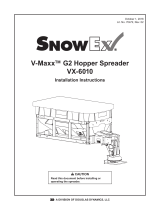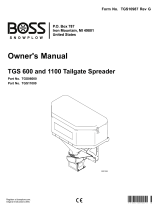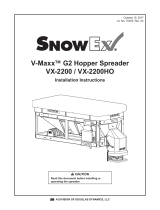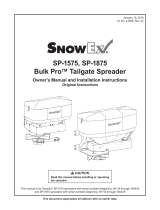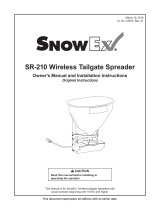Page is loading ...

CAUTION
Read this manual before installing or
operating the spreader.
October 1, 2018
Lit. No. 94430, Rev. 09
This manual is for WESTERN® Model 1000 & 2000 Low-Profi le Tailgate Spreaders
with serial numbers 10003 and higher (Model 1000) and 20364 and higher (Model 2000).
This manual supersedes all editions with an earlier date.
Low-Profi le Tailgate Spreader
68800, 67440
Model 1000 & 2000
Owner's Manual
Original Instructions


Lit. No. 94430, Rev. 09 3 October 1, 2018
TABLE OF CONTENTS
PREFACE .................................................................... 4
Owner's Information Form ....................................4
SAFETY ...................................................................... 5
Safety Defi nitions .................................................. 5
Warning/Caution Labels .......................................5
Serial Number Label ............................................. 6
Safety Precautions ................................................6
Fuses .................................................................... 7
Personal Safety..................................................... 7
Fire and Explosion ................................................ 7
Cell Phones ........................................................... 7
Ventilation ............................................................. 8
Battery Safety ....................................................... 8
Noise ..................................................................... 8
Vibrati on ................................................................8
Torque Chart ......................................................... 8
LOADING .................................................................... 9
Certifi cation ........................................................... 9
Material Weights ................................................... 9
MOUNTING THE SPREADER ................................. 10
Receiver Mount Spreader ................................... 10
Fixed Mount Spreader ........................................ 11
SWING AWAY® Spreader ................................... 12
OPERATING THE SPREADER ................................ 13
Driving and Spreading on Snow and Ice ............ 13
Controls ............................................................... 14
Variable Speed (PWM) Control – New Style ...... 14
Variable Speed (PWM) Control – Old Style ........ 16
ON/OFF Control .................................................. 17
REMOVING THE SPREADER ................................. 18
Receiver Mount ................................................... 18
Fixed Mount ........................................................ 18
SWING AWAY Mount .......................................... 19
MAINTENANCE ........................................................ 20
Preseason Check................................................ 20
After Each Use .................................................... 20
Postseason Maintenance.................................... 21
Drive Belt Replacement ...................................... 21
Bearing and Set Screw Maintenance .................22
Fuse Replacement ..............................................22
Recycle ...............................................................22
4-PIN HARNESS WIRING DIAGRAM ..................... 23
2-PIN HARNESS WIRING DIAGRAM ..................... 24
TROUBLESHOOTING GUIDE ................................. 25

Lit. No. 94430/94431, Rev. 09 4 October 1, 2018
Register your spreader online at www.westernplows.com
Owner Name: ______________________________________________________________________________
Date Purchased: ____________________________________________________________________________
Dealer Name: ______________________________________________ Phone: _________________________
Dealer Address: _____________________________________________________________________________
Vehicle Model/Year: _________________________________________________________________________
Spreader Type/Size (Model): _________________________________________ Weight: ______________ lb/kg
Spreader Serial Number:______________________________________________________________________
PREFACE
This manual has been prepared to acquaint you with
the safety information, operation, and maintenance of
your new spreader. Please read this manual carefully
and follow all recommendations. This will help ensure
profi table and trouble-free operation of your spreader.
Keep this manual accessible. It is a handy reference in
case minor service is required.
When service is necessary, bring your spreader to
your local dealer. They know your spreader best and
are interested in your complete satisfaction.
NOTE: This spreader is designed to spread
snow- and ice-control materials only. Do not use
it for purposes other than those specifi ed in this
manual.

Lit. No. 94430/94431, Rev. 09 5 October 1, 2018
SAFETY
SAFETY DEFINITIONS
NOTE: Indicates a situation or action that can lead
to damage to your spreader and vehicle or other
property. Other useful information can also be
described.
WARNING
Indicates a potentially hazardous situation
that, if not avoided, could result in death or
serious personal injury.
CAUTION
Indicates a potentially hazardous situation
that, if not avoided, may result in minor to
moderate injury. It may also be used to alert
against unsafe practices.
Warning/Caution Label
(both sides)
Warning Label
(receiver mount only)
Caution Label (both sides,
SWING AWAY® mount only)
WARNING/CAUTION LABELS
Please become familiar with and inform users about
the warning and caution labels on the spreader.
NOTE: If labels are missing or cannot be read, see
your sales outlet.
Warning Label

Lit. No. 94430/94431, Rev. 09 6 October 1, 2018
SAFETY
SAFETY PRECAUTIONS
Improper installation and operation could cause
personal injury and/or equipment and property
damage. Read and understand labels and this
Owner's Manual before installing, operating, or making
adjustments.
WARNING
• Driver to keep bystanders minimum of
25 feet away from operating spreader.
• Before working with the spreader, secure all
loose-fi tting clothing and unrestrained hair.
• Before operating the spreader, verify that all
safety guards are in place.
• Before servicing the spreader, wait for
conveyor, auger, and spinner to stop.
• Do not climb into or ride on spreader.
WARNING
Overloading could result in an
accident or damage. Do not exceed
GVWR or GAWR ratings as found
on the driver-side vehicle door
cornerpost. See Loading section to determine
maximum volumes of spreading material.
CAUTION
If rear directional, CHMSL light, or brake
stoplights are obstructed by the spreader,
the lights shall be relocated, or auxiliary
directional or brake stoplights shall be
installed.
WARNING
Do not install the control for this product in
the deployment path of an air bag. Refer to
vehicle manufacturer's manual for air bag
deployment area(s).
SERIAL NUMBER LABEL
Code Defi nition
YY 2-Digit Year
MM 2-Digit Month
DD 2-Digit Day
LL 2-Digit Location Code
XXXX 4-Digit Sequential Number
ZZZZZZ 5–7-Digit Assembly PN
WARNING
Vehicles <10,000 lb GVWR: Obstructing the
visibility from the vehicle's rear camera could
result in serious injury or damage. An auxiliary
camera system shall be installed if the
vehicle's rear camera is removed or blocked.
##############################
YYMMDDLLXXXXZZZZZ
YYMMDDLLXXXXZZZZZ

Lit. No. 94430/94431, Rev. 09 7 October 1, 2018
PERSONAL SAFETY
• Remove ignition key and put the vehicle in PARK
or in gear to prevent others from starting the
vehicle during installation or service.
• Wear only snug-fi tting clothing while working on
your vehicle or spreader.
• Do not wear jewelry or a necktie, and secure long
hair.
• Wear safety goggles to protect your eyes from
battery acid, gasoline, dirt, and dust.
• Avoid touching hot surfaces such as the engine,
radiator, hoses, and exhaust pipes.
• Always have a fi re extinguisher rated BC handy,
for fl ammable liquids and electrical fi res.
FIRE AND EXPLOSION
Be careful when using gasoline. Do not use gasoline
to clean parts. Store only in approved containers away
from sources of heat or fl ame.
CELL PHONES
A driver's fi rst responsibility is the safe operation of
the vehicle. The most important thing you can do
to prevent a crash is to avoid distractions and pay
attention to the road. Wait until it is safe to operate
Mobile Communication Equipment such as cell phones,
text messaging devices, pagers, or two-way radios.
SAFETY
FUSES
The electrical system contains several
automotive-style fuses. If a problem should occur
and fuse replacement is necessary, the replacement
fuse must be of the same type and amperage rating
as the original. Installing a fuse with a higher rating
can damage the system and could start a fi re. Fuse
Replacement, including fuse ratings and locations, is
located in the Maintenance section of this Owner's
Manual.
CAUTION
During the hopper installation we recommend
the addition of an OSHA compliant Backup
Alarm. This alarm is required for OSHA
governed employers.
NOTE: Lubricate grease fi ttings after each use.
Use a good quality multipurpose grease.
CAUTION
Disconnect electric and/or hydraulic power
and tag out if required before servicing or
performing maintenance.
CAUTION
• Do not operate a spreader in need of
maintenance.
• Before operating the spreader, reassemble
any parts or hardware removed for cleaning
or adjusting.
• Before operating the spreader, remove
materials such as cleaning rags, brushes,
and hand tools from the spreader.
• Before operating the spreader, read the
engine owner's manual, if so equipped.
• While operating the spreader, use auxiliary
warning lights, except when prohibited by law.
• Tighten all fasteners according to the
Torque Chart. Refer to Torque Chart for the
recommended torque values.
CAUTION
DO NOT leave unused material in
hopper. Material can freeze or solidify,
causing unit to not work properly.
Empty and clean after each use.
WARNING
Gasoline is highly fl ammable and gasoline
vapor is explosive. Never smoke while
working on vehicle. Keep all open fl ames
away from gasoline tank and lines. Wipe up
any spilled gasoline immediately.

Lit. No. 94430/94431, Rev. 09 8 October 1, 2018
SAFETY
VENTILATION
BATTERY SAFETY
NOISE
Airborne noise emission during use is below 70 dB(A)
for the spreader operator.
VIBRATION
Operating spreader vibration does not exceed 2.5 m/s2
to the hand-arm or 0.5 m/s2 to the whole body.
1/4-20 109 154
1/4-28 121 171
5/16-18 150 212
5/16-24 170 240
3/8-16 269 376
3/8-24 297 420
7/16-14 429 606
7/16-20
9/16-12
9/16-18
5/8-11
5/8-18
3/4-10
3/4-16
7/8-9
7/8-14 474 669
644 9091-8
1-12 704 995
1/2-13
1/2-20
11.9
13.7
24.6
27.3
43.6
26.9
53.3
93
148
49.4
69.8
77.9
106.4
120.0
8.4
9.7
17.4
19.2
30.8
35.0
49.4
55.2
75.3
85.0
M6 x 1.00
M12 x 1.75
M8 x 1.25
M14 x 2.00
M10 x 1.50
M27 x 3.00
M22 x 2.50
M30 x 3.50
M24 x 3.00
M20 x 2.5011.1
19.5
38.5
67
107
7.7
613
778
1139
1545
450
428
562
796
1117
M33 x 3.50
M36 x 4.00
2101
2701
1468
1952
325
M16 x 2.00 231
167
M18 x 2.50 318222
Recommended Fastener Torque Chart
Size Size
Torque (f t- lb)
Grade
5
Grade
8
Metric Fasteners Class 8.8 and 10.9
These torque values apply to fasteners
except those noted in the instructions.
Torque (f t- lb)
Grade
5
Grade
8
Size Size
Torque (f t- lb)
Class
8.8
Class
10.9
Torque (f t- lb)
Class
8.8
Class
10.9
Inch Fasteners Grade 5 and Grade 8
CAUTION
Read instructions before assembling.
Fasteners should be fi nger tight until
instructed to tighten according to torque
chart. Use standard methods and practices
when attaching spreader including proper
personal protective safety equipment.
TORQUE CHART
CAUTION
Batteries normally produce explosive gases,
which can cause personal injury. Therefore,
do not allow fl ames, sparks, or lit tobacco
to come near the battery. When charging or
working near a battery, always cover your
face and protect your eyes, and also provide
ventilation.
• Batteries contain sulfuric acid, which burns
skin, eyes, and clothing.
• Disconnect the battery before removing or
replacing any electrical components.
WARNING
Vehicle exhaust contains lethal fumes.
Breathing these fumes, even in low
concentrations, can cause death. Never
operate a vehicle in an enclosed area without
venting exhaust to the outside.

Lit. No. 94430/94431, Rev. 09 9 October 1, 2018
LOADING
This Owner's Manual covers vehicles that have been
recommended for carrying the tailgate spreader.
Please see your local dealer for proper vehicle
applications.
CERTIFICATION
WARNING
Overloading could result in an accident or
damage. Do not exceed GVWR or GAWR
ratings as found on the driver-side vehicle
door cornerpost.
WARNING
New untitled vehicle installation of a spreader
requires National Highway Traffi c Safety
Administration altered vehicle certifi cation
labeling. Installer to verify that struck load of
snow or ice control material does not exceed
GVWR or GAWR rating label and complies
with FMVSS.
CAUTION
Read and adhere to manufacturer's
ice-control material package
labeling, including Material Safety
Data Sheet requirements.
7. 2 f t 3
3.1 ft3
10.6 ft3
Model 2000
5.9 ft3
3.1 ft3
8.0 ft3
Model 1000
MATERIAL WEIGHTS
Density
Material (lb/ft3)(lb/yd
3)(kg/m
3)
Salt 80 2160 1282
Sand 100 2700 1602
Material densities are approximate and are based on dry,
loose material. It is the responsibility of the operator to
know the weight of the material to be spread and the vehicle
carrying capacity.
NOTE: If spreader and ice control material loading
is in doubt, weigh vehicle for compliance with
vehicle ratings.

Lit. No. 94430/94431, Rev. 09 10 October 1, 2018
MOUNTING THE SPREADER
RECEIVER MOUNT SPREADER
NOTE: The spreader shall be installed according
to instructions supplied. Your local outlet is
trained to provide this service and service your
spreader with factory original parts.
CAUTION
During removal or mounting, securely grip
spreader to avoid dropping.
1. Attach the spreader to the receiver mount with six
3/8" x 1" cap screws.
2. Insert the assembled unit into the receiver hitch
and secure with pin (not included).
3. Plug the spreader harness into the vehicle
harness.
4. Use the supplied ratchet straps to secure the
assembly to the vehicle frame.
Attaching the straps to the vehicle bumper or
tailgate may result in vehicle or spreader damage.

Lit. No. 94430/94431, Rev. 09 11 October 1, 2018
FIXED MOUNT SPREADER
NOTE: The spreader shall be installed according
to instructions supplied. Your local outlet is
trained to provide this service and service your
spreader with factory original parts.
CAUTION
During removal or mounting, securely grip
spreader to avoid dropping.
MOUNTING THE SPREADER
1. Install the left and right top brackets to the truck
bed rail with two 1/2" cap screws, four 1/2" fl at
washers, and two 1/2" locknuts per side. Secure
the small mounting fl ange of each top bracket to
the bed rail using two 5/16" cap screws, two 5/16"
fl at washers, and two 5/16" locknuts per side.
NOTE: Pay special attention when drilling or
clamping dissimilar metals to aluminum bodies.
Galvanic corrosion can occur if not handled
properly. Contact vehicle manufacturer for
recommended attachment practices.
2. Place the spreader on the bumper and line up
the holes in the bottom feet with the holes in the
bumper.
3. Attach the spreader to the top brackets using two
3/8" cap screws and two 3/8" locknuts per side.
4. Attach the spreader to the bumper of the truck
using one 3/8" cap screw, one 3/8" fl at washer,
and one 3/8" locknut per side.
5. Plug the spreader harness into the vehicle
harness.

Lit. No. 94430/94431, Rev. 09 12 October 1, 2018
MOUNTING THE SPREADER
SWING AWAY® SPREADER
NOTE: The spreader shall be installed according
to instructions supplied. Your local outlet is
trained to provide this service and service your
spreader with factory original parts.
CAUTION
During removal or mounting, securely grip
spreader to avoid dropping.
1. Fasten the left and right top brackets along
with any shims to the truck bed rail with two
1/2" cap screws, two 1/2" fl at washers, and two
1/2" locknuts per bracket. Install the two 5/16" cap
screws and 5/16" locknuts to the side of the top
brackets.
NOTE: Pay special attention when drilling or
clamping dissimilar metals to aluminum bodies.
Galvanic corrosion can occur if not handled
properly. Contact vehicle manufacturer for
recommended attachment practices.
2. Place the left and right base plates on the bumper
of the truck and line up with the holes in the
bumper.
3. Attach the base plates to the bumper using three
3/8" cap screws, three 3/8" plain washers, any
shims, and three 3/8" locknuts per side.
4. Place the spreader on the base plates and insert
the hinge pins. Secure the hinge side by installing
one 1/4" cap screw and 1/4" locknut through the
hole in the base plate boss and hinge pin.
5. Install hitch pin clip through the base plate boss
and the removable hinge pin.
6. Plug the spreader harness into the vehicle
harness.
7. Plug the center high mounted stoplight (CHMSL)
cord into the vehicle stoplight harness.

Lit. No. 94430/94431, Rev. 09 13 October 1, 2018
DRIVING AND SPREADING
ON SNOW AND ICE
Follow your vehicle owner's manual instructions for
driving in snow and ice conditions. Remember, when
you drive on snow or ice, your wheels will not get good
traction. You cannot accelerate as quickly, turning
is more diffi cult, and you will need longer braking
distance. Wet and hard packed snow or ice offer the
worst tire traction. It is very easy to lose control. You
will have diffi culty accelerating. If you do get moving,
you may have poor steering and diffi cult braking,
which can cause you to slide out of control.
CAUTION
Drinking and then driving or spreading is
very dangerous. Your refl exes, perceptions,
attentiveness, and judgment can be affected
by even a small amount of alcohol. You can
have a serious or even fatal collision if you
drive after drinking. Please do not drink then
drive or spread ice-control materials.
OPERATING THE SPREADER
Here are some tips for driving in these conditions:
• Drive defensively.
• Do not drink, then drive or spread ice-control
materials.
• Spread or drive only when you have good visibility
for operating a vehicle.
• If you cannot see well due to snow or icy
conditions, you will need to slow down and keep
more space between you and other vehicles.
• Slow down, especially on higher-speed roads.
Your headlamps can light up only so much road
ahead.
• If you are tired, pull off in a safe place and rest.
• The spreader's size and location reduce driver
visibility to the rear of the vehicle. We recommend
an OSHA-compliant backup alarm for all governed
employers.
• Keep your windshield and all glass on your vehicle
clean to see around you.
• Dress properly for the weather. Wear layers of
clothing; as you get warm, you can take off layers.

Lit. No. 94430/94431, Rev. 09 14 October 1, 2018
Variable Speed (PWM) Control – New Style
Starting and Stopping the Motor
1. To start the spreader motor, press the
START/BLAST button and release. Both the
START/BLAST and OFF buttons will be backlit
when the motor is running. The spreader will
operate at the speed selected on the speed dial.
2. Press the OFF button to stop the motor.
The OFF button operates as an emergency stop
when required.
NOTE: The truck ignition must be ON to start the
spreader.
NOTE: If the truck ignition is turned OFF while the
spreader is running, the motor will stop.
OPERATING THE SPREADER
CONTROLS
There are two control options. They include the
Variable Speed (PWM) Control and the ON/OFF
Control. Both have had design changes. Identify older
and newer styles by the face plate diagrams below to
fi nd the appropriate operating instructions.
WARNING
Before starting the spreader, the driver shall
verify all bystanders are a minimum of 25 feet
away from operating spreader.
Speed Dial
ON/Maximum
Speed Button
Diagnostic
Indicator Light
OFF Button (emergency
stop when required)
CAUTION
If the unit is equipped with a
SWING AWAY® mount, both hinge pins
must be secured in the base plates before
operating the spreader or the vehicle.

Lit. No. 94430/94431, Rev. 09 15 October 1, 2018
NOTE: Always place the cover on the hopper to
prevent moisture buildup. Do not let the spreader
sit idle with material in the hopper for an extended
period of time. This can cause the material to
compact and reduce or stop the fl ow of material.
OPERATING THE SPREADER
Adjusting the Spinner Speed
The speed setting can be adjusted when the spreader
is either ON or OFF.
1. Turn the speed dial clockwise. The speed will
increase as the number of green LEDs illuminated
on the speed dial increases.
2. Turning the speed dial counterclockwise will
decrease the speed.
BLAST/Maximum Speed
1. Press and hold the START/BLAST button as long
as maximum speed is needed.
2. Release the button when maximum speed is no
longer needed. The control automatically returns
to the "ON" position and the speed shown on the
speed dial.
NOTE: When BLAST is used, the speed dial does
not move to the maximum speed setting, but
remains at the preset speed.
Diagnostic Indicator Light
The diagnostic indicator light located to the right of the
START/BLAST button remains dark unless a problem
with the motor or wiring is detected. The light will fl ash
a number of fl ashes in a row, pause, then repeat.
Count the fl ashes to determine the nature of the
malfunction and refer to the diagnostic chart below.
# of
Flashes Problem Possible Causes
0No fault –
2 No power Battery fuse is blown, or battery
cable is disconnected or faulty.
3 No motor Motor is disconnected.
4No ground
Spreader harness ground is
disconnected or faulty.
5 Overheated
Motor OFF due to controller
overheat, possibly caused by
frozen or jammed spreader.
6Excess
current
Over 35A for more than
1–2 seconds. (Higher overloads
are allowed for shorter periods.)
If additional information is needed, refer to the
Troubleshooting section of this manual.
CAUTION
Do not swing spreader with material in the
hopper.

Lit. No. 94430/94431, Rev. 09 16 October 1, 2018
OPERATING THE SPREADER
Variable Speed (PWM) Control – Old Style
Starting and Stopping the Motor
1. To start the spreader motor, press the power
switch to the "START/BLAST" position and
release. This is a momentary position and the
power switch will automatically return to the "ON"
position when released. The spreader will operate
at the speed selected on the speed dial.
2. Press the power switch to the "OFF" position to
stop the motor. The power switch will remain in
this position.
The power switch "OFF" position operates as an
emergency stop when required.
NOTE: The truck ignition must be ON to start the
spreader.
NOTE: If the truck ignition is turned OFF while the
spreader is running, the motor will stop.
Adjusting the Spinner Speed
The speed setting can be adjusted when the spreader
is either ON or OFF.
1. Turn the speed dial clockwise. Speed will increase
as the numbers on the speed dial increase.
2. Turning the speed dial counterclockwise will
decrease the speed.
BLAST/Maximum Speed
3. Press and hold the power switch in the
"START/BLAST" position as long as maximum
speed is needed.
4. Release the power switch when maximum speed
is no longer needed. The switch automatically
returns to the "ON" position and the speed shown
on the speed dial.
NOTE: When BLAST is used, the speed dial does
not move to the maximum speed setting, but
remains at the preset speed.
Spinner Indicator Lights
Two lights on the cab control indicate the status of the
motor:
• Left light is red and indicates a fault. When the red
(left) light is ON, the power is ON and the motor is
not running.
• Right light is green and indicates power is ON.
When the green (right) light is ON, there is power
to the control and the motor is running.
If there are problems while operating the spreader,
refer to the Troubleshooting section of this manual.
NOTE: Always place the cover on the hopper to
prevent moisture buildup. Do not let the spreader
sit idle with material in the hopper for an extended
period of time. This can cause the material to
compact and reduce or stop the fl ow of material.
CAUTION
Do not swing spreader with material in the
hopper.
WARNING
Before starting the spreader, the driver shall
verify that all bystanders are a minimum of
25 feet away from operating spreader.
START
BLAST
ON
OFF
SPINNER
MIN MAX
1
2
3
456
7
9
SPEED
8
Power Switch
(emergency stop
when required)
Spinner
Indicator
Lights
Speed Dial

Lit. No. 94430/94431, Rev. 09 17 October 1, 2018
OPERATING THE SPREADER
ON/OFF Control Starting and Stopping the Motor
1. Move the power switch to the "ON" position to
start the motor. The motor will start immediately.
The power switch will remain in this position.
2. Move the power switch to the "OFF" position to
stop the motor. The power switch will remain in
this position.
The power switch "OFF" position operates as an
emergency stop when required.
NOTE: The truck ignition must be ON to start the
spreader.
NOTE: If the truck ignition is turned OFF while the
spreader is running, the motor will stop.
BLAST/Maximum Speed (New Style Only)
Move and hold the power switch to the "BLAST"
position for as long as maximum speed is needed.
When released, the switch will automatically return to
the "OFF" position and stop the motor.
If there are problems while operating the spreader,
refer to the Troubleshooting section in this manual.
NOTE: Always place the cover on the hopper to
prevent moisture buildup. Do not let the spreader
sit idle with material in the hopper for an extended
period of time. This can cause the material to
compact and reduce or stop the fl ow of material.
BLAST
ON
OFF
SPINNER
ON/OFF Control Switch
(emergency stop
when required)
Spinner Indicator Light
(when lit, indicates
power to the motor)
New Style
ON
OFF
RESET
15
POWER
Circuit Breaker
(resets control)
ON/OFF Control Switch
(emergency stop
when required)
Old Style
WARNING
Before starting the spreader, the driver shall
verify that all bystanders are a minimum of
25 feet away from operating spreader.
CAUTION
Do not swing spreader with material in the
hopper.

Lit. No. 94430/94431, Rev. 09 18 October 1, 2018
RECEIVER MOUNT
Removing the Spreader
1. Unplug the spreader.
2. Remove the pin from the receiver hitch.
3. Remove the spreader from the vehicle and stand it
in an upright position. This may require additional
support.
REMOVING THE SPREADER
CAUTION
During removal or mounting, securely grip
spreader to avoid dropping.
FIXED MOUNT
Removing the Spreader
1. Unplug the spreader and CHMSL (if equipped).
2. Remove the two 3/8" cap screws, washers, and
locknuts that fasten the spreader to the bumper of
the vehicle.
3. Use an additional person or clamps to support
the unit and then remove the four 3/8" cap screws
and locknuts that fasten the spreader to the top
brackets.
4. Remove the spreader from the vehicle and stand
in an upright position. This may require additional
support.
Removing the Brackets
1. Remove the two 1/2" cap screws, washers,
and locknuts that fasten each top bracket to the
bed rail.
2. Remove the two 5/16" cap screws, washers, and
locknuts that fasten each top bracket to the side of
the bed rail.
3. Package the brackets with all hardware and store
them with the unit.
CAUTION
Empty the hopper before removing the
spreader.

Lit. No. 94430/94431, Rev. 09 19 October 1, 2018
SWING AWAY® MOUNT
Removing the Spreader
1. Unplug the spreader and CHMSL (if equipped).
2. Remove the hitch pin from the latch-side hinge pin.
3. Remove the 1/4" cap screw and locknut from the
hinged-side hinge pin.
4. Use an additional person to support the unit and
remove both hinge pins.
5. Remove the spreader from the vehicle and stand it
in an upright position. This may require additional
support.
Removing the Top Brackets
1. Remove the two 1/2" cap screws, washers,
and locknuts that fasten each top bracket to the
bed rail.
2. Remove the two 5/16" cap screws and locknuts
that fasten each top bracket to the side of the
bed rail.
3. Mark the location of any shims to aid in
reinstallation.
4. Package the brackets with all hardware and store
with the unit.
REMOVING THE SPREADER
Removing the Base Plates
1. Remove the four 3/8" cap screws, washers,
locknuts, and any shims that fasten the base plate
to the bumper.
2. Mark the location of the shims to aid in
reinstallation.
3. Package the base plates with all hardware and
store with the unit.

Lit. No. 94430/94431, Rev. 09 20 October 1, 2018
MAINTENANCE
PRESEASON CHECK
Before the unit is placed in service for the ice control
season, make sure that it is in top working condition.
Here are some tips for getting your spreader ready.
Remove the motor cap assembly and inspect the
following:
1. Check the condition of the drive belt. Any cracks
or damaged teeth indicate the need for a new belt.
See "Drive Belt Replacement" in this section.
2. Check the motor connection terminals for damage
or corrosion. Clean or replace as necessary and
coat with dielectric grease.
3. Check the condition of the drive shaft bearings by
fi rst removing the drive belt. To remove the drive
belt see "Drive Belt Replacement" in this section.
With the drive belt removed, spin the drive shaft
by hand. Any excess noise or roughness in either
bearing may indicate bearing failure.
4. If bearings pass inspection, be sure to
thoroughly grease them with a good quality
multipurpose grease. See "Bearing and Set Screw
Maintenance" in this section.
5. Verify that all drive sprocket set screws are tight.
Verify that all other fasteners are tight. Refer to the
torque chart in the Safety section of this manual.
6. Check the condition of the motor cap assembly
seal. This seal is very important to the reliability of
the unit. Replace the seal if needed.
7. Check the condition of the spinner disk. If the vanes
are excessively worn, the unit may not spread as
intended. Replace the spinner if necessary.
8. Replace the motor cap assembly and locknuts.
9. Verify that vehicle stoplights and spreader CHMSL
are visible and working properly.
AFTER EACH USE
Disconnect the electrical plug located between the
spreader and the truck before cleaning.
1. Thoroughly clean the unit inside and out using
tap water or a high-pressure washer. Avoid
spraying water into bearings, motor, and electrical
connections. A long-handled brush can be used to
aid cleaning.
2. Apply dielectric grease to all electrical connections
to prevent corrosion.
3. Lubricate the drive shaft bearings with a good
quality multipurpose grease.
CAUTION
• Do not operate a spreader in need of
maintenance.
• Before operating the spreader, reassemble
any parts or hardware removed for cleaning
or adjusting.
• Before operating the spreader, remove
materials such as cleaning rags, brushes,
and hand tools from the spreader.
• Empty and clean spreader after every use.
Material can freeze or solidify, causing unit
to not work properly.
CAUTION
Disconnect electric power at spreader
electrical wiring harness connection and tag
out if required before servicing or performing
maintenance.
/


